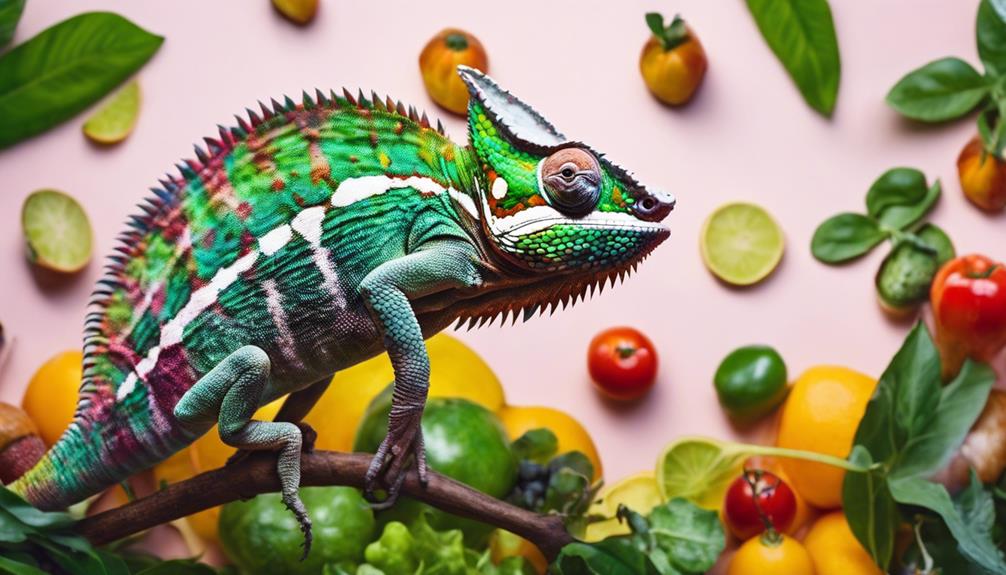Imagine your chameleon exploring their enclosure, effortlessly blending into the vibrant green leaves of a Monstera plant.
However, before you let your chameleon roam freely, there are essential considerations regarding the safety of these trendy plants.
While Monstera plants can add aesthetic appeal to your chameleon’s habitat, a vital question lingers: are Monstera plants truly safe for your chameleon companions?
Yes, Monstera plants are generally safe for chameleons; they’re often used in enclosures without issues. However, they contain oxalic acid, which is slightly toxic, so chameleons should not eat them.
Potential Risks of Monstera Plants
When considering the care of your chameleon, it’s essential to understand the potential risks associated with Monstera plants. These decorative plants, while visually appealing, can be toxic to chameleons if ingested. Monstera plants contain insoluble calcium oxalates, which can cause severe discomfort and health issues for your pet. It’s important to make sure that your chameleon doesn’t eat any part of the Monstera plant to prevent poisoning.
While Monstera plants are generally safe for chameleons to climb on, the real danger lies in ingestion. Chameleons might be tempted to nibble on the leaves or stems of these plants, unknowingly exposing themselves to harmful substances. As a responsible chameleon owner, you have to carefully monitor your pet’s interactions with Monstera plants and intervene if necessary to prevent any consumption.
Benefits of Monstera Plants
Chameleon owners must be aware of the potential benefits Monstera plants can offer within their pet’s habitat, including opportunities for climbing and natural shelter. Monstera plants provide chameleons with the chance to exhibit their natural climbing behaviors, promoting physical activity and mental stimulation. The large, lush leaves of the Monstera plant create a shaded area that can serve as a safe retreat for chameleons seeking shelter or a break from light exposure. Additionally, incorporating Monstera plants into the chameleon habitat not only enhances the aesthetic appeal but also mimics their natural environment, encouraging exploration and engagement. By strategically placing these plants, chameleon owners can create a dynamic and enriching space that meets their pets’ needs for both physical activity and mental well-being.
| Benefits of Monstera Plants for Chameleons |
|---|
| 1. Climbing Opportunities |
| 2. Natural Shelter |
| 3. Aesthetic Appeal |
| 4. Encourages Exploration |
| 5. Engaging Environment |
Safety Measures for Chameleons
Implementing safety measures is critical when incorporating Monstera plants into chameleon habitats to prevent potential risks associated with toxicity. While Monstera plants offer safe climbing opportunities for chameleons like pothos plants, caution must be exercised to make certain these plants aren’t ingested.
Chameleons should be prevented from consuming Monstera plants due to their insoluble calcium oxalates, which can cause health issues. Proper placement of Monstera Deliciosa and Monstera Adansonii on moss poles or trellises can enhance chameleon enclosures while minimizing risks.
Ensuring that these plants are out of the chameleons’ reach or securely positioned can help prevent accidental consumption. By taking these safety measures, chameleon owners can create enriching environments for their pets without compromising their well-being.
Alternatives to Monstera Plants
Consider incorporating alternative safe plants such as Ficus benjamina, Schefflera/Umbrella Tree, Pothos Plant, Geranium, and Poplar to provide enriching environments for your chameleons while minimizing potential risks associated with toxicity.
Ficus benjamina and Schefflera/Umbrella Tree serve as excellent centerpieces, offering both visual appeal and functionality. These plants provide climbing opportunities and hiding spots for your chameleons to explore.
The Pothos Plant, a popular trailing option, can be strategically placed to create hiding spaces and even serve as a drinking surface for your chameleons.
Geranium and Poplar plants are safe choices that can enhance your chameleon’s enclosure, contributing to a more natural environment.
Expert Recommendations
For expert recommendations on incorporating Monstera plants in chameleon habitats, consult with experienced herpetologists or reptile veterinarians knowledgeable about safe plant choices for reptiles. When considering Monstera Deliciosa for your chameleon’s enclosure, it’s critical to be cautious due to their toxicity. Here are some expert recommendations:
- Consult with a herpetologist: Seek guidance from professionals who specialize in reptiles to guarantee the safety of your chameleon.
- Avoid ingestion: While Monstera plants provide climbing opportunities for your chameleon, make sure they don’t consume any part of the plant due to its toxicity.
- Monitor for signs of toxicity: Keep a close eye on your chameleon for any unusual behavior or symptoms that may indicate plant ingestion.
- Provide alternative climbing options: Incorporate other non-toxic plants or structures like moss poles to offer additional climbing opportunities while keeping your chameleon safe from potential harm.
Frequently Asked Questions
Is Monstera Deliciosa Safe for Reptiles?
When considering reptile safety, Monstera Deliciosa is not recommended due to its toxicity. Opt for safe plant options to enhance environmental enrichment, mimic natural habitats, provide nutritional benefits, and offer behavioral stimulation for your chameleon.
What Plants Are Toxic to Chameleons?
When choosing plants for your chameleon’s habitat, be mindful of poisonous varieties that could harm your pet. Avoid toxic options like Alocasia or Ficus pumila var. quercifolia to guarantee the safety of your reptile friend.
Are Monstera Plants Toxic to Pets?
Monstera plants can be toxic to pets due to insoluble calcium oxalates. Chameleons should avoid consuming Monstera plants to prevent oral irritation, drooling, vomiting, and swallowing issues. Provide safe, non-toxic plant options for chameleons in their enclosure.
What Plants Are Good for Chameleons?
When caring for chameleons, it’s important to provide safe foliage options in their habitats. Consider non-toxic plants like Pothos, Schefflera, Hibiscus, Vitis, and Malagasy-origin species to enhance chameleon care and guarantee their well-being.
Conclusion
In summary, while Monstera plants can be safe for chameleons to climb on, it’s important to be cautious of their toxicity. Despite the potential risks, proper care and safety measures can prevent any harm to chameleons.
One may argue that finding alternative non-toxic plants for chameleon enclosures can be challenging, but with proper research and guidance from experts, it’s possible to provide a safe and enriching environment for these unique reptiles.


